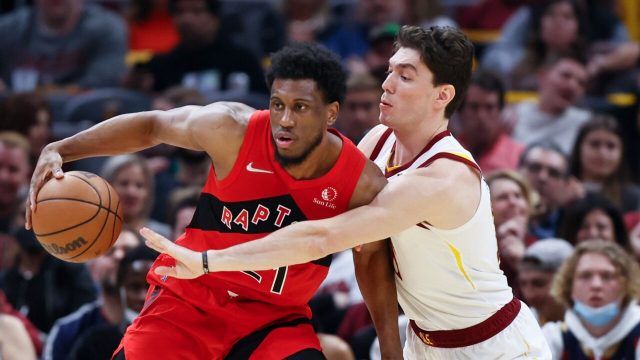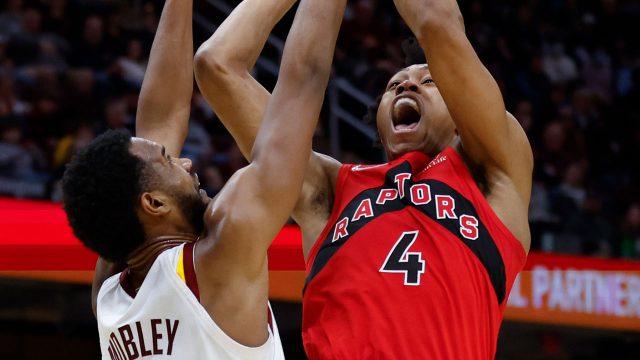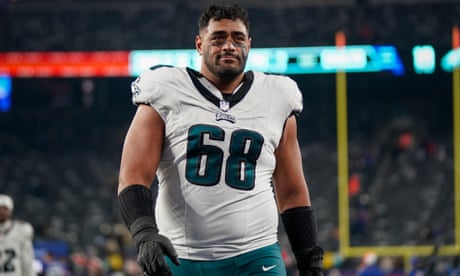
Here are 10 takeaways from the Toronto Raptors‘ 104-96 loss to the Cleveland Cavaliers.
One — Raptors games are painful at the moment. In their current condition with Fred VanVleet sidelined, there is not a single team in the league that has less reliable guard production than what the Raptors offer. Ironically, it’s a feature rather than a failure of their team design, as the front office clearly has a vision of playing positionless basketball which essentially means having five forwards on at once, at all times.
But, in this early stage of their development, there is not enough playmaking or outside shooting to supply the offence, which leaves the Raptors only two ways to win. One, they would need to nail every detail, win the possession battle in turnovers and offensive rebounds, while being airtight defensively. Two, they would need to run into a bottom feeder like the Nets without their star players.
Two — The lack of shooting on this roster negates everything else that works in their favour. VanVleet and OG Anunoby missing at once means they’re short 17 three-point attempts and nearly seven made threes from their lineup, and there is no depth behind them to pick up the slack. The Raptors hit just one three in the first half, and finished the game with six total makes on 24 attempts.
The only willing shooters from three tonight were Gary Trent Jr., who showed some signs of life but is still stuck in a horrible slump, and Chris Boucher, whose mid-season turnaround was accredited to his disciplined shot selection and improved focus on the defensive end. Needless to say, the Raptors could not generate enough offence to compete. You could dominate every other aspect of the game but no team in the league will consistently win in the modern game while hitting single digits in threes. The math simply doesn’t work.
Three — The Raptors in their current state also lack playmaking. Nick Nurse turned to Pascal Siakam and Scottie Barnes as his de facto point guards, while Dalano Banton hardly touched the ball in his nine minutes off the bench. There are advantages to be created from playing through the forwards, as Siakam and Barnes both used their size and touch to great effect on drives to the rim.
But their efficiency drops with each additional body that the Cavaliers were able to stack in the lane, and it’s not as if the kickout is a particularly useful option when nobody around them is making shots. The Cavaliers went to a zone early on, but also just nailed the basics like going under screens, helping early and often, while also securing the defensive glass. Even when the Raptors’ forwards were able to beat multiple defenders, they were so exhausted from the effort that their legs were missing at the free-throw line. Siakam and Barnes shot a combined 10-for-19 from the stripe.

Four — Trent Jr. is the Raptors’ best bet as a backcourt creator, but he is new to this role. For most of the year, Trent Jr. has been an effective outlet option where Siakam, VanVleet, Anunoby and Barnes would collapse the paint before finding Trent Jr. open. That luxury is now gone, and Trent Jr. is having to create which is not his strength. He doesn’t look for the pass nearly enough for someone who takes so many shots, nor does he get downhill enough to pull extra defenders his way to create the chance to pass.
This issue becomes compounded when Trent Jr. is now seeing the best perimeter defenders that would ordinarily be assigned to VanVleet or even Siakam, as the Cavaliers did tonight with Isaac Okoro face-guarding Trent Jr. and limiting his attempts. Trent Jr. managed to create some half-decent chances for himself, particularly in the midrange, but the Raptors need a lot more than he is able to provide at the moment.
Five — Barnes was promising in the moments he chose to take over on offence. His ability to out-muscle players on drives, maintain his position while pivoting and hooking shots over top of the defence often catches teams by surprise. Even in the instances where the shot doesn’t drop, he has shown all season an ability to bump his defender on the rebound to win the tip-in.
Barnes always has the pass in mind, where he’s able to pick out cutters like Boucher darting through the middle, or driving in for the lay-off when the second defender commits towards him. The only ask would be for Barnes to remain aggressive for longer stretches. Too often, he will defer to Siakam and Trent Jr., and while he can sneak in for the occasional cut, Barnes doesn’t offer much value playing off the ball.
Six — Barnes’ inexperience showed more on defence, where he is overeager. The ability is certainly there for him to make difficult plays, such as on his chase-down block against Cedi Osman on what looked to be a guaranteed layup had it not been for Barnes’ length and explosiveness. However, for every highlight stop, there are two or three errors that need to be corrected.
For example, Siakam was visibly confused by Barnes’ decision to abandon the weakside shooter, help all the way across the lane on a post up where Khem Birch had good position against Evan Mobley, who simply threw it to Barnes’ man for the three to force a timeout. On another sequence in the fourth, Barnes pressed up way too aggressively on Dean Wade, to the point where an average forward with average quickness was able to get by Barnes before dunking over Birch who was understandably caught off guard.
For now, the Raptors should keep Barnes on non-shooters so his tendency to wander isn’t as impactful, and instruct him to leave a gap on defence so that he isn’t easily giving up dribble penetration.
Seven — Mobley and Barnes were both excellent on the whole. Mobley showed the same tenacity on the offensive glass, drained a deep three to beat the clock, and played very effective defence against Siakam during parts of the second half.
Where he struggled was creating from the post, where the Raptors were able to bump him and keep him from taking a steady attempt. Barnes also scored over Mobley on two instances, using his strength to muscle to get to his spot ahead of Mobley who was forced to take the foul. But then again, Mobley also swatted Barnes’ attempt at a midrange jumper without even needing to leave the ground. Ironically, the two rookies who are so often pitted against each other can learn a lot from how the other plays.

Eight — Boucher is always productive as a spot starter. Nurse recognized the need for more size against a Cavaliers side that started three 7-footers, and Boucher delivered. He was strong defensively against Mobley aside from keeping him off the glass, ran the floor hard which got him easy dunks in transition, and he hit half of the Raptors’ threes.
There aren’t many players who can take on more shots to make up for the injuries, but Boucher has a strong case for more minutes and more shots, especially on nights where he’s hunting for his chances. He seems to pair well with Barnes, who always finds him in transition.
Nine — Whether the Raptors use Khem Birch or Precious Achiuwa in the middle, the result is that there isn’t enough production at centre. Birch started off poorly, showing no willingness to attack while also not being able to contain the pick-and-roll where Darius Garland was able to repeatedly serve up dunks to his bigs. Achiuwa came in and was much better in the first half, where he showed his potential as a driver getting downhill and scoring in the paint. But in the second half, Birch was much more lively on defence, and was more willing to use showcase his athleticism on both ends, so he got more of the minutes. Regardless of how Nurse mixes and matches his centres, the bottom line is that he will rarely get 48 minutes of consistent play.
Ten — Nurse’s defensive game plan focused on neutralizing Garland. The Raptors covered him in a box-and-one early in the first half, where Banton or Trent Jr. would stick tightly with Garland and refuse to help off regardless of where he was positioned on the floor. In the third quarter, the Raptors shifted to trapping Garland, even out to halfcourt, in an attempt to force other players to beat them rather than allowing Cleveland’s all-star guard to operate. Garland never quite got into a rhythm and recorded seven turnovers. But unlike the Raptors, the Cavaliers had more depth around the roster to score, such as Kevin Love and Cedi Osman combining for 32 points which is four times as many points as the Raptors’ bench mustered in total.







